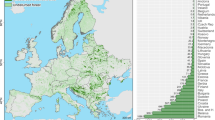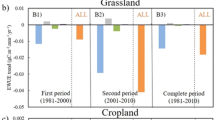Abstract
Arising from T. F. Keenan et al. Nature 499, 324–327 (2013)10.1038/nature12291
Forests in North America and northern Europe increased their water-use efficiency (WUE)—the ratio of photosynthetic CO2 uptake to water loss through evapotranspiration—over the last two decades, according to a recent Letter1. Keenan et al. attribute the rising WUE to fertilization by increasing levels of atmospheric CO2 (ref. 1), although biosphere models predict this effect to be much smaller than the observed trend. Here, I show that falling concentrations of ozone and other phytotoxic air pollutants, which were not considered in ref. 1, may explain part of the WUE trend. Future efforts to reconcile biosphere models with field data should, therefore, use integrated modelling approaches that include both air quality and CO2 effects on forest growth and water use. There is a Reply to this Brief Communication Arising by Keenan, T. F. et al. Nature 507, http://dx.doi.org/10.1038/nature13114 (2014).
This is a preview of subscription content, access via your institution
Access options
Subscribe to this journal
Receive 51 print issues and online access
$199.00 per year
only $3.90 per issue
Buy this article
- Purchase on Springer Link
- Instant access to full article PDF
Prices may be subject to local taxes which are calculated during checkout

Similar content being viewed by others
References
Keenan, T. F. et al. Increase in forest water-use efficiency as atmospheric carbon dioxide concentrations rise. Nature 499, 324–327 (2013)
Sitch, S., Cox, P. M., Collins, W. J. & Huntingford, C. Indirect radiative forcing of climate change through ozone effects on the land-carbon sink. Nature 448, 791–794 (2007)
Chappelka, A. H. & Samuelson, L. J. Ambient ozone effects on forest trees of the eastern United States. New Phytol. 139, 91–108 (1998)
Skärby, L., Ro-poulsen, H., Wellburn, F. A. M. & Sheppard, L. J. Impacts of ozone on forests: a European perspective. New Phytol. 139, 109–122 (1998)
Ainsworth, E. A., Yendrek, C. R., Sitch, S., Collins, W. J. & Emberson, L. D. The effects of tropospheric ozone on net primary productivity and implications for climate change. Annu. Rev. Plant Biol. 63, 637–661 (2012)
Wittig, V. E., Ainsworth, E. A., Naidu, S. L., Karnowky, D. F. & Long, S. P. Quantifying the impact of current and future tropospheric ozone on tree biomass, growth, physiology and biochemistry: a quantitative meta-analysis. Glob. Change Biol. 15, 396–424 (2009)
McLaughlin, S. B., Nosal, M., Wullschleger, S. D. & Sun, G. Interactive effects of ozone and climate on tree growth and water use in a southern Appalachian forest in the USA. New Phytol. 174, 109–124 (2007)
Lombardozzi, D., Levis, S., Bonan, G. & Sparks, J. P. Predicting photosynthesis and transpiration responses to ozone: decoupling modeled photosynthesis and stomatal conductance. Biogeosciences 9, 3113–3130 (2012)
Cooper, O. R., Gao, R.-S., Tarasick, D., Leblanc, T. & Sweeney, C. Long-term ozone trends at rural ozone monitoring sites across the United States, 1990–2010. J. Geophys. Res. 117, D22307 (2012)
Tørseth, K. et al. Introduction to the European Monitoring and Evaluation Programme (EMEP) and observed atmospheric composition change during 1972–2009. Atmos. Chem. Phys. 12, 5447–5481 (2012)
WHO. Air Quality Guidelines for Europe 2nd edn, 219–251, http://www.euro.who.int/__data/assets/pdf_file/0005/74732/E71922.pdf (World Health Organization Regional Office for Europe, 2000)
Karlsson, P. E. et al. New critical levels for ozone effects on young trees based on AOT40 and simulated cumulative leaf uptake of ozone. Atmos. Environ. 38, 2283–2294 (2004)
Calatayud, V., Cerveró, J. & Sanz, M. J. Foliar, physiological and growth responses of four maple species exposed to ozone. Wat. Air Soil Pollut. 185, 239–254 (2007)
Franks, P. J. et al. Sensitivity of plants to changing atmospheric CO2 concentration: from the geological past to the next century. New Phytol. 197, 1077–1094 (2013)
Hoshika, Y., Omasa, K. & Paoletti, E. Whole-tree water use efficiency is decreased by ambient ozone and not affected by O3-induced stomatal sluggishness. PLoS ONE 7, e39270 (2012)
Author information
Authors and Affiliations
Corresponding author
Ethics declarations
Competing interests
Declared none.
PowerPoint slides
Rights and permissions
About this article
Cite this article
Holmes, C. Air pollution and forest water use. Nature 507, E1–E2 (2014). https://doi.org/10.1038/nature13113
Received:
Accepted:
Published:
Issue Date:
DOI: https://doi.org/10.1038/nature13113
This article is cited by
-
Ozone-induced stomatal sluggishness changes carbon and water balance of temperate deciduous forests
Scientific Reports (2015)
-
Water-use efficiency and transpiration across European forests during the Anthropocene
Nature Climate Change (2015)
-
Keenan et al. reply
Nature (2014)
Comments
By submitting a comment you agree to abide by our Terms and Community Guidelines. If you find something abusive or that does not comply with our terms or guidelines please flag it as inappropriate.



